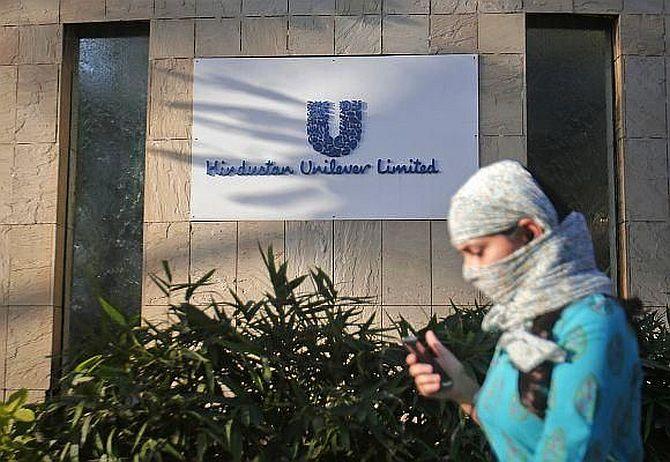There is no near-term respite for the country’s largest fast-moving consumer goods maker, Hindustan Unilever (HUL), which is facing multiple challenges on the growth front.

With demand showing no signs of improvement, especially in the rural segment, the October–December quarter (Q3) of 2023–24 (FY24) is likely to be similar to the previous quarter, with volume growth in the low single digits.
The stock, which is down 7 per cent over the past year compared to the 11 per cent jump for the S&P BSE Sensex, could underperform the benchmark in the near term as well.
Going ahead, investors will track the pace of volume recovery, pricing actions, and margin movement for the consumer major.
Volume growth on a year-on-year (Y-o-Y) basis has been trending down for four consecutive quarters, with the company registering a 2 per cent uptick in the July–September quarter (Q2) of FY24.
Research analyst Mihir P Shah of Nomura Research says, “Volume growth will likely remain lacklustre due to lower-than-expected festival demand and will be similar to that in Q2FY24.
"We expect similar trends to continue for another couple of quarters, with normalisation likely after the first quarter of 2024–25.”
Even as the premium segment is growing faster than the mass segment and urban markets are faring better, it is the slowdown in the rural segment that has dragged down the consumer giant’s overall performance over the past few quarters.
While inflation has moderated, an uneven and weak monsoon (minus 5.6 per cent of the long-period average) has impacted the kharif (summer) crop harvest with a 3.8 per cent decline in crop production, according to the First Advance Estimates by the Ministry of Agriculture.
Improvement here is critical, as 40 per cent of its annual revenues come from rural areas.
In addition to weak recovery in rural markets and tapering volume growth, two other areas have been hurdles to HUL’s growth in the recent past.
These are rising competition in the beauty and personal care (BPC) segment and slower growth in the foods business, especially the health food drinks portfolio.
To address the growth challenges in the BPC segment, the company has made management changes and split BPC into the beauty and well-being and personal care divisions.
This will be effective in April 2024.
While beauty and well-being will be headed by Harman Dhillon, the personal care business will be run by Kartik Chandrasekhar.
The company also appointed Arun Neelakantan as chief digital officer to pursue new growth opportunities by leveraging the digital ecosystem in the country.
The BPC business is the largest segment of HUL and accounted for 38 per cent of its Q2FY24 revenues.
The margins in the business at 27–28 per cent are by far the highest across its three key divisions (home care and foods are the others) and are 400–500 basis points (bps) more than the company average.
Senior analyst Shirish Pardeshi of Centrum Broking says, “Since BPC is the source of value creation for HUL, these changes indicate strategic intent to lift performance as competition from regional as well as digital-to-consumer brands is scaling up fast.”
He also points out that the GSK Consumer Healthcare acquisition, with a focus on the high-science benefit segment, has taken a longer time to stabilise than expected.
The company is also ramping up its merger and acquisition strategy to leverage growth, yet two recent acquisitions may take longer to settle, says the brokerage.
While these steps could take time to fructify and reverse the sluggishness on the volume and revenue growth fronts, the other key trigger for the stock would be its ability to maintain or improve margins.
The company expanded its gross margins by 692 bps Y-o-Y and 282 bps on a sequential basis to 52.7 per cent in Q2FY24 on the back of lower raw material costs.
However, increased advertising and promotion costs and other expenses limited the expansion in operating profit margins to 130 bps at 24.2 per cent.
While brokerages expect margins to expand even in Q3FY24, the gains will be limited or offset a bit by the higher expenditure on advertising and brand-building activities to counter increased competitive intensity.
A positive for the company is the fall in crude oil and its derivatives, which will reduce the raw material cost basket for the company.
If Brent crude oil prices at $75 per barrel continue to sustain for longer periods, the company will have the flexibility to either improve volumes by cutting down on prices, increase its advertising budget, or improve margins by maintaining them at current levels.
While most brokerages have a ‘buy’ or ‘add’ rating and valuations are not demanding, investors are better served with a cautious approach, given the current commentary on volumes.
Disclaimer: This article is meant for information purposes only. This article and information do not constitute a distribution, an endorsement, an investment advice, an offer to buy or sell or the solicitation of an offer to buy or sell any securities/schemes or any other financial products/investment products mentioned in this article to influence the opinion or behaviour of the investors/recipients.
Any use of the information/any investment and investment related decisions of the investors/recipients are at their sole discretion and risk. Any advice herein is made on a general basis and does not take into account the specific investment objectives of the specific person or group of persons. Opinions expressed herein are subject to change without notice.











